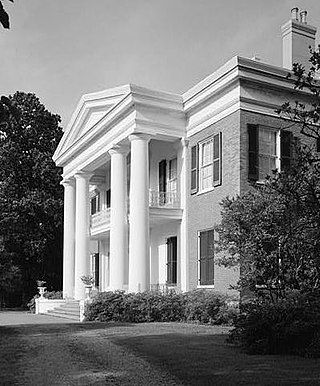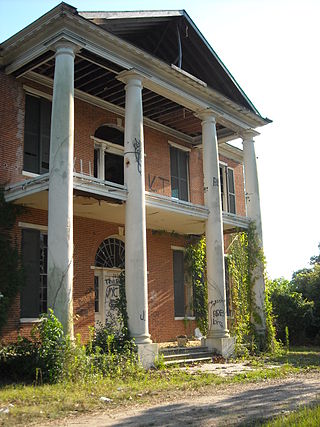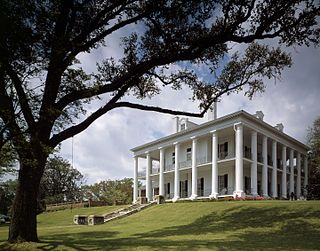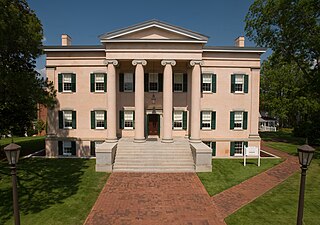
Natchez National Historical Park commemorates the history of Natchez, Mississippi, and is managed by the National Park Service.

Bellevue is a historic mansion house at 204 Ben Hill Street in LaGrange, Georgia, United States. Built in 1853–1855, it was the home of Senator Benjamin Harvey Hill, and is one of the state's finest examples of Greek Revival architecture. Now a historic house museum, it was designated a National Historic Landmark in 1973, and is a contributing structure in Broad Street Historic District.

The Samuel Russell House is a neoclassical house at 350 High Street in Middletown, Connecticut, built in 1828 to a design by architect Ithiel Town. Many architectural historians consider it to be one of the finest Greek Revival mansions in the northeastern United States. Town's client was Samuel Russell (1789-1862), the founder of Russell & Company, the largest and most important American firm to do business in the China trade in the 19th century, and whose fortunes were primarily based on smuggling illegal and addictive opium into China.

The Mississippi Governor's Mansion is the official residence of the governor of Mississippi which is currently Tate Reeves. It is located in downtown Jackson, Mississippi, south of the Mississippi State Capitol, at the south end of Smith Park. Completed in 1841 to a design by state architect William Nichols, it is the second-oldest governor's residence in active use in the nation, and a prominent example of Greek Revival architecture. It was designated a National Historic Landmark in 1975, and was declared a Mississippi Landmark in 1985.

The Lanier Mansion is a historic house located at 601 West First Street in the Madison Historic District of Madison, Indiana. Built by wealthy banker James F. D. Lanier in 1844, the house was declared a State Memorial in 1926, and remains an important landmark in Madison to the present day. It was designated a National Historic Landmark in 1994 as one of the nation's finest examples of Greek Revival architecture.

Longwood, also known as Nutt's Folly, is a historic antebellum octagonal mansion located at 140 Lower Woodville Road in Natchez, Mississippi, United States. Built in part by enslaved people, the mansion is on the U.S. National Register of Historic Places, and is a National Historic Landmark. Longwood is the largest octagonal house in the United States.

Oakland Memorial Chapel is a historic church and academic building on the campus of Alcorn State University in rural southwestern Claiborne County, Mississippi. Built in 1838 as part of Oakland College, it is one of the oldest surviving buildings at Alcorn State, which took over that defunct school's campus after the American Civil War. Alcorn State was the first land grant university established specifically for the education of African Americans. The chapel was designated a National Historic Landmark in 1976, and was designated a Mississippi Landmark in 1985.

Arlington is a historic Federal style house and outbuildings in Natchez, Mississippi. The 55-acre (22 ha) property, which includes three contributing buildings, was listed on the National Register of Historic Places in 1973. It was further declared a National Historic Landmark in 1974. Following a fire that destroyed much of the main house, it was placed on Mississippi's 10 most endangered historic places for 2009 by the Mississippi Heritage Trust.

Auburn is an antebellum mansion in Duncan Park in Natchez, Mississippi. It was designed and constructed by Levi Weeks in 1812, and was the first building to exhibit Greek Revival order in the town. Its prominent two-story Greek portico served as a model for the subsequent architectural development of local mansions. It was declared a National Historic Landmark in 1974 and a Mississippi Landmark in 1984.

The Commercial Bank and Banker's House is an unusual combination building, housing both a bank premises and the principal banker's residence, at 206 Main Street and 107 Canal Street in Natchez, Mississippi. Built-in 1833, it is a remarkably high-quality and well-preserved example of Greek Revival architecture. It was designated a National Historic Landmark in 1974. The bank portion of the building, used for a time by a Christian Science congregation, is presently vacant, while the house portion is a private residence. Both the buildings have carved limestone used extensively, columns lintels, window sills, and the entire facia are all carved limestone with the walls being 20" thick brick construction with scored plaster to have the appearance of large limestone blocks.

Dunleith is an antebellum mansion at 84 Homochitto Street in Natchez, Mississippi. Built about 1855, it is Mississippi's only surviving example of a plantation house with a fully encircling colonnade of Greek Revival columns, a form once seen much more frequently than today. Now an inn and conference center, it was designated a National Historic Landmark in 1974. Currently the original horse stable serves as a fine dining establishment with a traditional English pub in the lower levels of the structure

Melrose is a 15,000 square feet (1,400 m2) mansion, located in Natchez, Mississippi, that is said to reflect "perfection" in its Greek Revival design. The 80-acre (320,000 m2) estate is now part of Natchez National Historical Park and is open to the public by guided tours. The house is furnished for the period just before the Civil War. Melrose was declared a National Historic Landmark in 1974.

Monmouth is a historic antebellum home located at 1358 John A. Quitman Boulevard in Natchez, Mississippi on a 26-acre (11 ha) lot. It was built in 1818 by John Hankinson, and renovated about 1853 by John A. Quitman, a former Governor of Mississippi and well-known figure in the Mexican–American War. It is one of Natchez's grandest Greek Revival mansions. It was declared a Mississippi Landmark in 1986 and a National Historic Landmark in 1988. It is now a small luxury hotel.

Stanton Hall, also known as Belfast, is an Antebellum Classical Revival mansion at 401 High Street in Natchez, Mississippi. Built in the 1850s, it is one of the most opulent antebellum mansions to survive in the southeastern United States. It is now operated as a historic house museum by the Pilgrimage Garden Club. The house was declared a National Historic Landmark in 1974 and a Mississippi Landmark in 1995.

The James C. Flood Mansion is a historic mansion at 1000 California Street, atop Nob Hill in San Francisco, California, USA. Now home of the Pacific-Union Club, it was built in 1886 as the townhouse for James C. Flood, a 19th-century silver baron. It was the first brownstone building west of the Mississippi River, and the only mansion on Nob Hill to structurally survive the 1906 San Francisco earthquake and fire. It was declared a National Historic Landmark in 1966.

The Herndon Home is a historic house museum and National Historic Landmark at 587 University Place NW, in Atlanta, Georgia. An elegant Classical Revival mansion with Beaux Arts influences, it was the home of Alonzo Franklin Herndon (1858-1927), a rags-to-riches success story who was born into slavery, but went on to become Atlanta's first black millionaire as founder and head of the Atlanta Life Insurance Company. The house was designed by his wife Adrienne, and was almost entirely built with African-American labor. The house was declared a National Historic Landmark in 2000, and had previously been declared a "landmark building exterior" by the city of Atlanta in 1989.

Georgia's Old Governor's Mansion is a historic house museum located on the campus of Georgia College & State University (GCSU) at 120 South Clarke Street in Milledgeville, Georgia. Built in 1839, it is one of the finest examples of Greek Revival architecture in the American South, and was designated a National Historic Landmark for its architecture in 1973. It served as Georgia's executive mansion from 1839- 1868, and has from 1889 been a university property, serving for a time as its official president's residence. It is an accredited museum of the American Alliance of Museums and in 2015 was named an affiliate of the Smithsonian Institution.

The Burn, a house built in 1834, is the oldest documented Greek Revival residence in Natchez, Mississippi. It was built on a knoll to the north of the old town area of Natchez. It was listed on the National Register of Historic Places in 1979.

The U.S. Custom House, also known as the Old Post Office and Custom House, is a historic government building at 423 Canal Street in New Orleans, Louisiana. It was designated a National Historic Landmark, receiving this designation in 1974 and noted for its Egyptian Revival columns. Construction on the building, designed to house multiple federal offices and store goods, began in 1848 and didn't finish until 1881 due to redesigns and the American Civil War. The U.S. Customs offices have been located there since the late 19th century.

The Follett House is a historic house at 63 College Street in Burlington, Vermont. Built in 1840 for a prominent local businessman, it is the last surviving grand 19th-century lakeside mansion in the city, and one of the state's finest examples of Greek Revival architecture. It was listed on the National Register of Historic Places in 1972. It has seen commercial and institutional uses since 1885.


























